
From top to bottom: two Turkish neys (a kiz ney and a yildiz ney), an Iranian ney, and a kaval.
In a large part of the world, the historical and currently used flutes are rim-blown flutes, not transverse flutes. These regions include parts or all of the Balkan states, the Arabic states, Turkey, Iran, the countries of Central Asia, etc. Small duct flutes may be used for folk music, and modern Boehm flutes are, of course, found in orchestras in all these countries today. But the rim-blown flutes are used extensively in traditional ensembles as well as popular music.
The bodies of neys and kavals are tubes open at both ends. To sound them, the air stream is directed toward a side of the circular, beveled rim of one end. There is no duct or "notch" of any kind.
Shown below are two Turkish neys, an Iranian ney, and a Bulgarian kaval. I know most about the Turkish ney, and describe it with some detail. Short sections on the Iranian ney and the kaval follow.

These instruments are chromatic in the sense that a single instrument can handle numerous modes (scales) with different tonics and intervals. The finger holes are placed so that opening the holes one-by-one, starting with the all-holes-covered position, most often produces intervals of a semitone. This is in stark contrast with the fingering that one finds on the baroque flute, penny whistle, bansuri, dizi, and many other six-hole flutes, where the intervals produced by raising the fingers one-by-one are mostly whole tones (whole tone, whole tone, semitone, whole tone, whole tone, whole tone). Neys and kavals can handle numerous scales comprised of semitones, whole tones, and augmented seconds without the use of so-called forked fingerings, though half or partial covering of holes is necessary for some notes.
The sacrifice entailed by this placement of finger holes is that there is a gap (missing notes) between the top of the first octave (first harmonics, or fundamentals) and the beginning of the second octave (second harmonics). Though all instruments on this page have a thumb hole, there are not enough fingers to cover holes for all the semitones in the first octave.

The Turkish ney (also spelled nay) is made from a nine-segment section of reed (cane), the exterior of which is left natural in shape and color. The blowing end is furnished with a removable "mouthpiece" (başpâre), traditionally of horn or wood but today often made of plastic, which includes the rim (blowing edge) and a flaring "lip rest". There is some curvature in the interior sides of the başpâre, which presumably affects the sound and response in some ways. The başpâre is a difference between the Turkish neys and the Egyptian or Arabic neys, which are made without this mouthpiece but are otherwise essentially the same. The Iranian or Persian ney, on the other hand, differs in significant ways from the Turksish ney (see below).
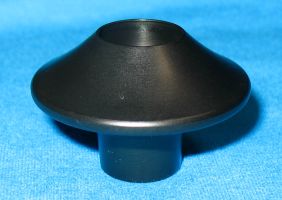
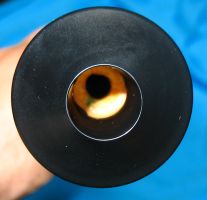
The bore is basically cylindrical, but retains the natural interior walls of the reed, which, of course, are not completely smooth or cylindrical. The nodal dams of the reed are mostly removed, but the bore remains a but lumpy. The material under the first node, near the blowing end, is only perforated, so that there is a constriction in the bore at this point.
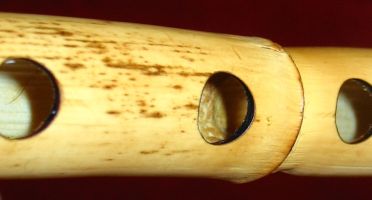
There are seven holes, six finger holes that are relatively close together and low on the tube, and a thumb hole in back quite a bit higher than the highest finger hole. The thumb hole on the Turkish ney is used only for a small range of notes at the top of the rarely-used low octave. It is normally kept closed.

The bore of the Turkish ney is narrow for its length, with the result that the high harmonics speak easily while the first harmonics (fundamentals) are weak. The lowest fundamentals are very difficult. Fundamentals may be used in taksim (improvisations, introductions) but they are rarely used in the classical repertoire.
When the six finger holes of the ney are opened one-by-one, starting from the bottom, the intervals produced are: whole tone, semitone, semitone, semitone, semitone, semitone (though the semitones are not all of the same size). This means that the interval from the all-holes-covered position to the all-fingers-off (but thumb on) position is a perfect fifth and not a major seventh as one finds on many six-hole flutes.
Modern notation shows the lowest note of the Turkish ney as g below middle c'. But the useful range starts with the octave g'. The second, third, and fourth harmonics, taking the instrument from g' to d''', are sufficient for normal playing. But some fifth and sixth harmonics can be sounded. All harmonics on the ney are played "unassisted", i.e. without vent holes opened. (This is common on end-blown flutes, including the Giorgi flute.) No cross-fingerings or forked fingerings are needed on the ney; they are, as we said, not required to assist the speech of harmonics; nor are they used for missing semitones or microtones, which are produced with shading or partial closing of sounding holes as well as embouchure adjustments.
A simplified fingering chart is given below. The thumb hole is closed for all these notes and is not shown in the table. (The ney does not produce these notes in equal temperament. In particular, the notes I have labeled b', f''#, and b'' are flat to equal temperament.) The entries in a light font are fingerings that are not often used; "X" indicates a closed hole, and "O" an open one; the highest finger holes are on the left. For a complete fingering chart, go to http://www.bardoworks.it/Ney_Chart1.html . [Internet Explorer is recommended. This link freezes my version of Mozilla Firefox.] Here is the first octave.
|
|
|
|
|
|---|
Microtones and differently-sized semitones are part of Turkish classical music performance. One common theory divides the whole tone into nine koma (commas). The are four commas between B and C, and between E and F, so that there are 53 commas in an octave.

Key signatures found in Turkish ney music may look unusual to those who know only western notation.



While no cross-fingerings are acoustically necessary on the ney, they do occur when some fingers are put on, or left on, their holes to support and steady the instrument. For example, the d'' may be played as OXO OXO (right-most photo below), rather than with all fingers off, without significantly affecting the intonation, and this also makes transition to c'' and e'' easier.
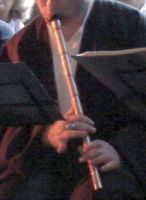
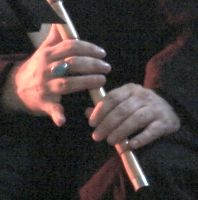
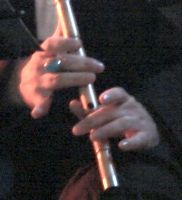
The thumb hole may be used to bridge the gap from the first harmonic d' to the g' that starts the second harmonic range. With all fingers off and the thumb hole entirely open, an f'# can be sounded, though it tends to be flat. Lower notes f' and e' can be obtained by embouchure adjustment and partial covering of the thumb hole.
Sound production on the ney differs from that on transverse flutes. On the latter, the lips are pulled back, to varying extents, to form a more-or-less narrow horizontal slit for the air stream. For the ney, the lips are pursed as if whistling, producing a round hole for the air stream, which is directed at the right or left side of the rim while the instrument is held obliquely to the other side. Excellent diagrams of the embouchure and the placement of the ney may be found here. That page suggests that the lowest (first harmonic) notes are produced with a breath pressure approximating that used to warm ones hands on a cold winter day.
The tongue is not used for articulation on the ney; playing is often smooth and legato, but notes may be separated with ornaments or slight emphasis with the breath. Some vibrato may be used as a special effect, especially in taksim—it is often produced by movement of the instrument or lips. A portamento produced by sliding fingers off or on their holes is very common.

The ney is made in a variety of sizes. The largest common size is the mansur ney, which plays at pitch; all holes closed sounds g'. But also common are the kiz ney and the yildez ney—shown in the photo at the top of this page—which sound, respectively, a whole tone and a minor third above the mansur ney. These are easier to play. The mansur ney requires a large stretch.
The ney has a long tradition of use in the spiritual Sufi ceremonies of the Mevlevi (whirling dervishes).

Good web resources for the Turkish ney include:
The first page includes instructions for learning the ney and a huge archive of written-out ney music. In addition, many sound samples may be found by searching for "ney" or "Turkish ney" at http://youtube.com.
The Iranian ney is also made of reed, often a section with seven segments. It usually has wide mounts, normally brass, at both ends. The one at the bottom is protective and decorative, but the top tube (the sari) forms the blowing edge. A unique inter-dental blowing technique is used: one side of the sharp rim is positioned in the gap between the two front teeth. (If there is an insufficient gap between the front teeth, dental surgery is sometimes advised. It was advised in Iran for me, but I did not consider this seriously.) Both the upper lip and the tongue play a role in directing the air stream. This embouchure gives the instrument, especially in the lower register, a rich and characteristic sound unlike that of any other flute. Pictures of the embouchure and fiurther information may be found at http://members.shaw.ca/persianney/technique.html.
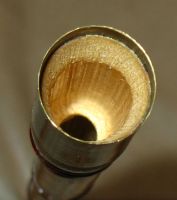
Unlike that of the Turkish ney, the lower register of the Iranian ney is strong. The upper register (second harmonics and higher) is brighter, and the contrast between the two registers (in part because of a gap in the range between them) is so great that they are usually not mixed; that is, a player will use the low register for some time and then switch to the upper registers for contrast, and alternate in this manner throughout a performance. This youtube video (start listening at 1:30 and at 2:30 into the video) illustrates this contrast well.

Persian neys are made in many sizes; a common size has low note c'. There are five finger holes on the front, and one thumb hole in the back. The bottom two holes are covered by the first and third fingers of the lower hand, while the second finger of that hand supports the ney by remaining fixed in a position between the two bottom holes. Click for a fingering chart. As the fingers are raised one-by-one from the all-holes-covered position, the following intervals are produced: whole tone, small whole tone, large semitone, semitone, semitone. So all-fingers-off produces g', and then opening the thumb hole gives a'. The notes b'b and b' are missing, though with the embouchure, when time permits, the second octave c'' can be flattened to give b' and the first octave a' can be sharpened to give b'b.
Circular breathing is a common technique on the Iranian ney. The
flexible embouchure allows for a large tonal and intonation range.
Some information on classical Persian tuning may be found
here.
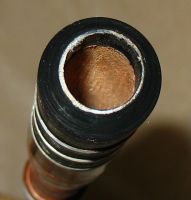
The kaval is a type of instrument found, in a variety of forms, throughout the Balkan states as well as in Turkey, Azerbaijan, Armenia, and Kurdistan. In some regions (e.g. Turkey) the word is occasionally used for a small duct flute, but it most often refers to a rim-blown flute made of wood with a completely cylindrical bore. The instrument is often associated with shepherds and folk music.
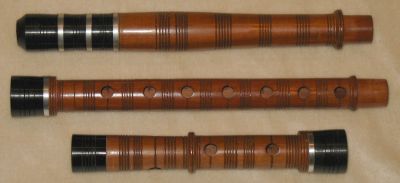

The Bulgarian kaval is made in three sections. The middle section contains seven finger holes and one thumb hole. The bottom section has four always-open holes for venting and tuning, The most common size Bulgarian kaval has lowest note d'. Raising the fingers one-by-one produces first a whole tone and then a scale of semitones. If one starts with the lowest note, opening the seven finger holes one-by-one takes the pitch from d' to b'b, and then uncovering the thumb hole gives b'. The thumb hole is not used for any other note. The notes c'' and c''# are missing from the range. The second octave starts with d''. Then a scale of a whole tone followed by semitones is obtained. The notes c''' and c'''#, and higher notes, are available as third harmonics.
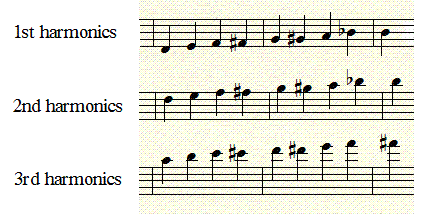
Fourth and higher harmonics are used. Fingering charts may be found here.
In practice, the lowest octave is not often used; when used, the higher harmonics are brought out so that a reedy, clarinet-like effect results. This mode is called kaba and can be heard on youtube, from 1:02 to 1:16 into the video.
For more on the kaval see http://www.robertsnider.com/Kavals/.